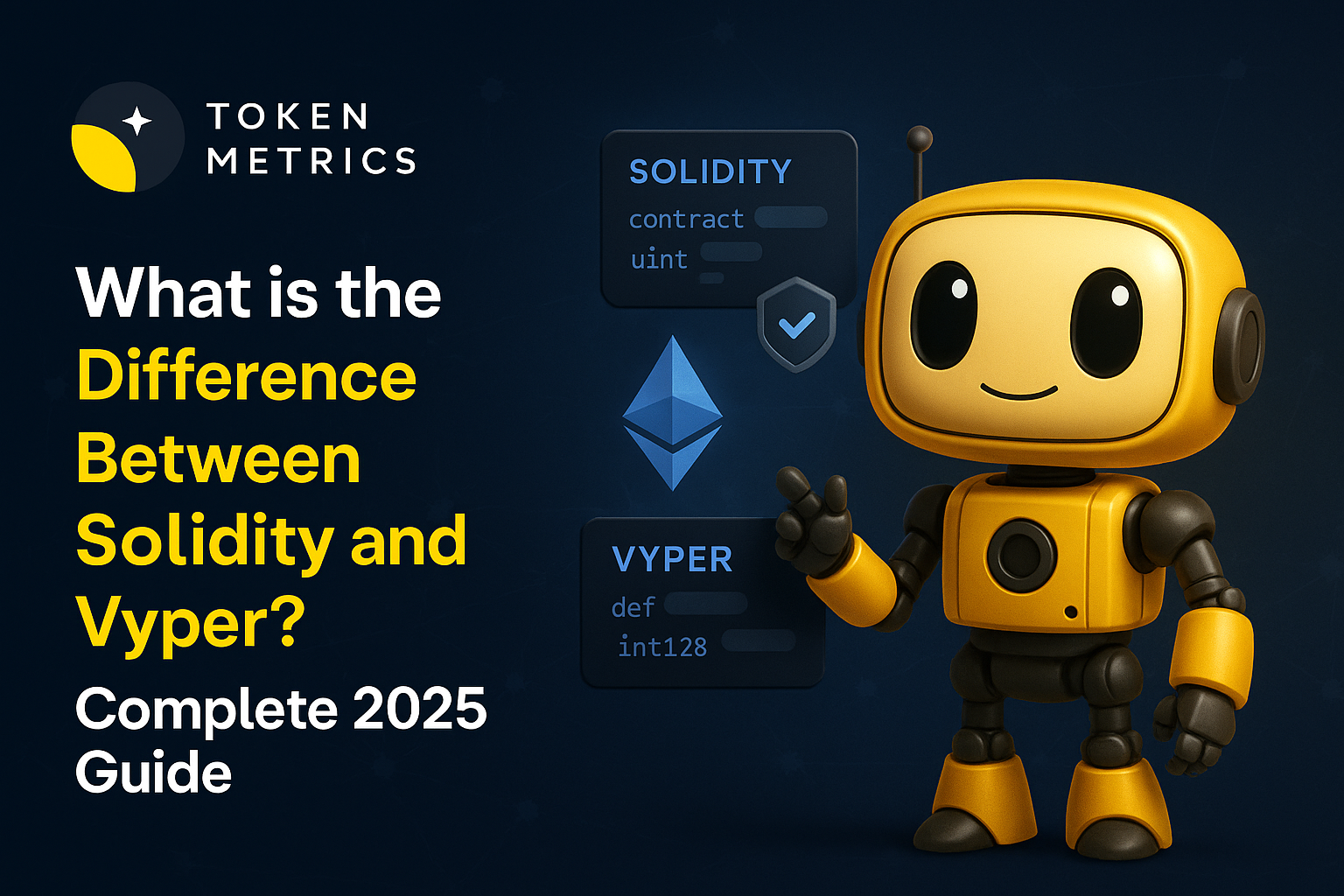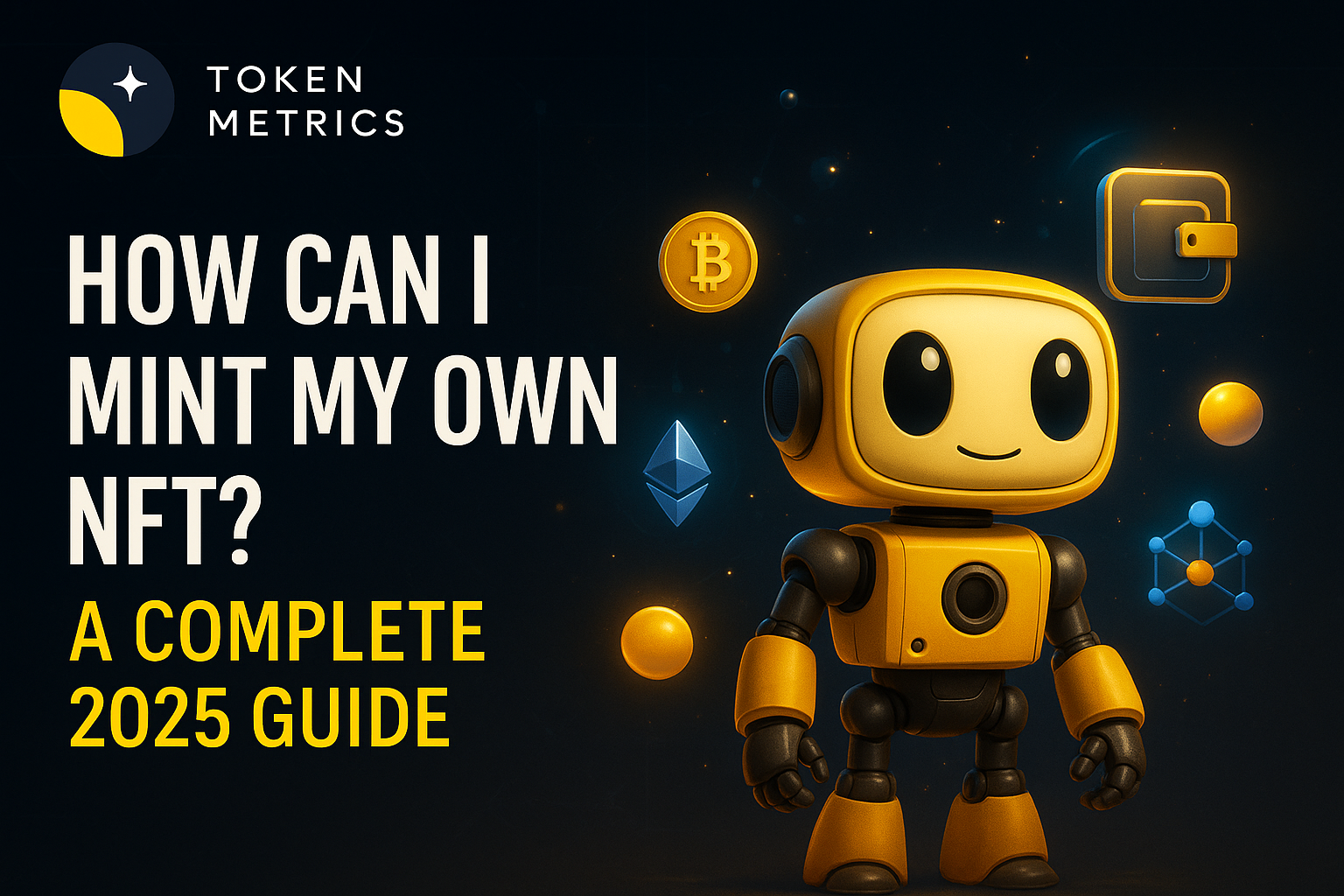What is the Difference Between Solidity and Vyper? Complete 2025 Guide

Smart contracts have revolutionized the blockchain ecosystem, enabling self-executing code that automatically enforces agreed-upon terms and conditions. As decentralized applications continue growing in sophistication and value, the programming languages used to create these contracts become increasingly critical. Two languages dominate Ethereum smart contract development: Solidity and Vyper. Token Metrics.
Understanding Smart Contract Languages
Before diving into Solidity vs Vyper comparison, it's essential to understand what smart contract languages do and why they matter. Smart contracts are programs that run on blockchain platforms like Ethereum, executing predetermined actions when specific conditions are met. These contracts facilitate secure, transparent, and trustless interactions between parties, eliminating intermediaries and enhancing efficiency.
Smart contract languages enable developers to define the logic and behavior of these contracts, which are immutable and executed on the blockchain. By leveraging smart contract languages, businesses can automate processes including supply chain management, financial transactions, governance systems, and much more.
High-Level vs Low-Level Languages
Smart contract programming requires converting human-readable code into machine-executable bytecode that the Ethereum Virtual Machine (EVM) can process. Developers must first choose between high-level and low-level languages based on their use case and expertise.
High-level languages abstract away granular implementation details, allowing developers to create smart contracts without deep bytecode knowledge. Solidity and Vyper are both high-level languages designed for EVM-compatible blockchains, making them accessible to developers from traditional programming backgrounds.
After compilation, both Solidity and Vyper smart contracts execute using the same bytecode language, meaning they can be used concurrently in the same application despite their different source code appearances.
Solidity: The Industry Standard
Solidity is the most widely used programming language for developing smart contracts on the Ethereum blockchain and EVM-compatible chains. Designed specifically for blockchain applications, Solidity enables developers to create secure, decentralized, and automated agreements that run on distributed networks.
Origins and Design Philosophy
Proposed by Ethereum CTO Gavin Wood, Solidity was developed to meet demand for a flexible smart contract-based developer platform. The language draws heavily on inspiration from C++, JavaScript, and Python, making it familiar to developers from various programming backgrounds.
Solidity is a high-level, Turing-complete, statically typed language where developers must explicitly declare variable types. This allows the compiler to have knowledge of data types, ensuring deterministic application behavior—a critical requirement for blockchain applications where predictability is paramount.
Key Features of Solidity
- Object-Oriented Programming: Supports inheritance, libraries, and complex data structures for sophisticated smart contracts with reusable components.
- Rich Feature Set: Includes function overloading, multiple inheritance, user-defined types, and complex data structures.
- Extensive Ecosystem: Benefits from a large community support, documentation, and development tools like Remix, Hardhat, and Foundry.
- Blockchain-Specific Commands: Built-in commands for addresses, transactions, and block data interactions.
- Wide Adoption: Most Ethereum projects, including Uniswap, Aave, and OpenSea, are developed using Solidity.
Advantages of Solidity
- Market Dominance: Secures 87% of DeFi TVL, making it the dominant language for decentralized finance.
- Robust Tooling: Mature ecosystem with testing, debugging, and analysis tools.
- Versatility: Enables implementation of complex protocols, financial instruments, and governance procedures.
- Learning Resources: Abundant tutorials, courses, and community support.
Disadvantages of Solidity
- Security Vulnerabilities: Increased attack surface with risks like reentrancy and integer overflows, requiring thorough audits.
- Complexity: Extensive features can lead to harder-to-audit contracts and hidden vulnerabilities.
- Steeper Learning Curve: Requires understanding blockchain-specific security considerations.
Vyper: The Security-First Alternative
Vyper is a contract-oriented programming language that targets the EVM with a focus on security, simplicity, and auditability. Introduced in 2018 by Ethereum co-founder Vitalik Buterin, Vyper was specifically developed to address security issues prevalent in Solidity.
Design Philosophy: Security Through Simplicity
Vyper's fundamental philosophy is that security comes from simplicity and readability. The language intentionally limits features and enforces stricter syntax to make contracts more secure and easier to audit. By reducing what’s possible, Vyper minimizes opportunities for mistakes and vulnerabilities.
Using Pythonic syntax—hence the serpentine name—Vyper code prioritizes readability so developers can easily detect bugs and vulnerabilities before deploying contracts. This approach makes code auditable by humans, not just machines.
Key Features of Vyper
- Python-Like Syntax: Familiar for Python developers, with indentation-based structure and clear syntax.
- Security-First Design: Eliminates object-oriented features, such as inheritance and function overloading, to reduce attack vectors.
- Strong Typing: Variables require explicit type declaration, catching errors early.
- Bounds Checking & Overflow Protection: Built-in safety features prevent common vulnerabilities.
- Decidability & Gas Optimization: Ensures predictable gas consumption and avoids infinite loops, making contracts more efficient.
Advantages of Vyper
- Enhanced Security: Designed specifically to prevent common vulnerabilities, leading to more secure contracts.
- Readable & Audit-Friendly: Clear syntax facilitates quicker reviews and lower audit costs.
- Concise Code: Fewer lines and simpler syntax streamline contract development.
- Python Background: Eases onboarding for Python programmers.
- Potential Gas Savings: Simple design can lead to more efficient contracts in specific cases.
Disadvantages of Vyper
- Limited Adoption: Only about 8% of DeFi TVL, with a smaller ecosystem and community.
- Fewer Features: Lack of inheritance, modifiers, and function overloading limits architectural options.
- Smaller Tooling Ecosystem: Development tools and libraries are less mature compared to Solidity.
- Less Industry Traction: Major projects predominantly use Solidity, limiting existing examples for Vyper development.
Differences: Solidity vs Vyper
- Syntax & Structure: Solidity resembles JavaScript and C++, with curly braces and semicolons; Vyper uses Python-like indentation and syntax, omitting object-oriented features.
- Feature Completeness: Solidity offers inheritance, modifiers, and dynamic data structures; Vyper is minimalist, focusing on security with fixed-size arrays and no inheritance.
- Security Approach: Solidity relies on developer diligence and testing; Vyper enforces limitations to inherently prevent vulnerabilities.
- Development Philosophy: Solidity emphasizes flexibility, while Vyper emphasizes security and auditability.
Choosing Between Solidity and Vyper
The decision depends on project needs, team expertise, and security priorities. Large, feature-rich DeFi protocols and complex dApps typically require Solidity's extensive capabilities. Conversely, systems demanding maximum security, or contracts that need to be highly auditable, may benefit from Vyper’s simplicity and security-focused design.
Many projects effectively combine both, using Vyper for security-critical core components and Solidity for peripheral features. This hybrid approach leverages the strengths of each language.
Leveraging Token Metrics for Smart Contract Analysis
While understanding the distinctions between Solidity and Vyper is valuable for developers, investors should also evaluate the projects' underlying code quality, security track record, and development activity. Token Metrics offers AI-powered analytics that examine code repositories, audit statuses, and project activity levels.
The platform reviews security vulnerabilities, audit history, and real-time security incidents, providing a comprehensive view that helps identify projects with strong technical foundations, regardless of their chosen language.
Furthermore, Token Metrics tracks project development activity via GitHub, helping gauge ongoing commitment and progress. Market intelligence and performance analysis reveal success patterns and areas of risk, supporting informed decision-making.
Token Metrics assists investors in balancing portfolios across projects built with different languages, offering risk assessments and alerts that enhance proactive management amid evolving blockchain security landscapes.
The Future of Smart Contract Languages
Both Solidity and Vyper are actively evolving to meet new challenges and security needs. Solidity continues enhancing security features, error handling, and optimization, driven by its large ecosystem. Vyper development emphasizes expanding capabilities while maintaining its core security principles.
Emerging languages and cross-language development strategies are beginning to complement established techniques. Combining secure core contracts in Vyper with the flexibility of Solidity is an increasingly common pattern.
Best Practices for Smart Contract Development
- Thorough Testing: Implement comprehensive testing, including formal verification and audits, before deployment.
- Security Audits: Engage reputable security firms to review code vulnerabilities.
- Continuous Monitoring: Use platforms like Token Metrics for real-time risk detection post-deployment.
- Upgradeability: Adopt upgrade patterns that allow fixing issues without losing funds or functionality.
Conclusion: Making the Right Choice
Solidity and Vyper offer distinct approaches to smart contract development. Solidity’s comprehensive features and robust ecosystem make it suitable for complex, feature-rich applications. Vyper's security-oriented, Python-like syntax is ideal for systems where auditability, simplicity, and security are top priorities.
Both languages will continue to play vital roles throughout 2025, with many projects adopting hybrid strategies. Evaluating project needs, security considerations, and team expertise will guide optimal language selection. AI analytics platforms like Token Metrics provide critical insights to support this decision, ensuring better understanding and risk management in the ever-evolving ecosystem.
Create Your Free Token Metrics Account

.png)




%201.svg)
%201.svg)


%201.svg)










.svg)




.png)